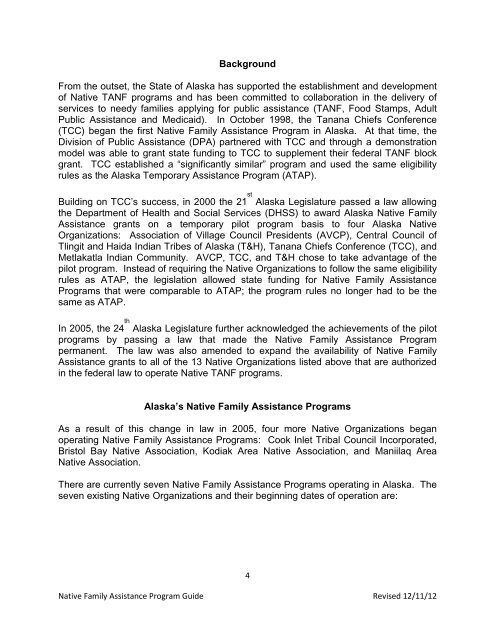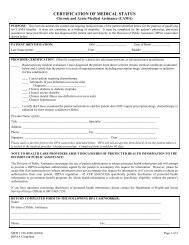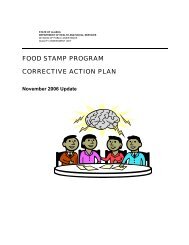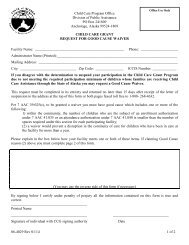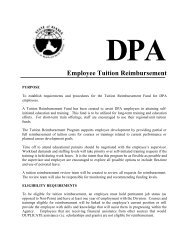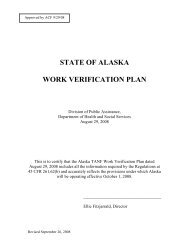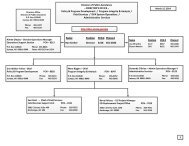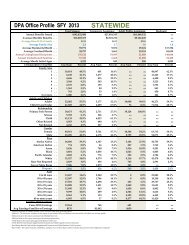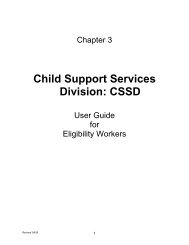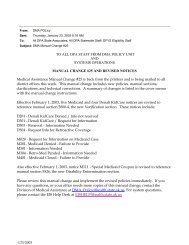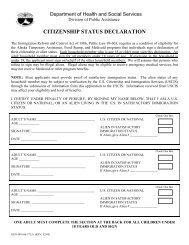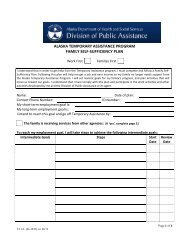Native Family Assistance Program Guide - DPAweb - Alaska ...
Native Family Assistance Program Guide - DPAweb - Alaska ...
Native Family Assistance Program Guide - DPAweb - Alaska ...
You also want an ePaper? Increase the reach of your titles
YUMPU automatically turns print PDFs into web optimized ePapers that Google loves.
BackgroundFrom the outset, the State of <strong>Alaska</strong> has supported the establishment and developmentof <strong>Native</strong> TANF programs and has been committed to collaboration in the delivery ofservices to needy families applying for public assistance (TANF, Food Stamps, AdultPublic <strong>Assistance</strong> and Medicaid). In October 1998, the Tanana Chiefs Conference(TCC) began the first <strong>Native</strong> <strong>Family</strong> <strong>Assistance</strong> <strong>Program</strong> in <strong>Alaska</strong>. At that time, theDivision of Public <strong>Assistance</strong> (DPA) partnered with TCC and through a demonstrationmodel was able to grant state funding to TCC to supplement their federal TANF blockgrant. TCC established a “significantly similar” program and used the same eligibilityrules as the <strong>Alaska</strong> Temporary <strong>Assistance</strong> <strong>Program</strong> (ATAP).Building on TCC’s success, in 2000 the 21 st <strong>Alaska</strong> Legislature passed a law allowingthe Department of Health and Social Services (DHSS) to award <strong>Alaska</strong> <strong>Native</strong> <strong>Family</strong><strong>Assistance</strong> grants on a temporary pilot program basis to four <strong>Alaska</strong> <strong>Native</strong>Organizations: Association of Village Council Presidents (AVCP), Central Council ofTlingit and Haida Indian Tribes of <strong>Alaska</strong> (T&H), Tanana Chiefs Conference (TCC), andMetlakatla Indian Community. AVCP, TCC, and T&H chose to take advantage of thepilot program. Instead of requiring the <strong>Native</strong> Organizations to follow the same eligibilityrules as ATAP, the legislation allowed state funding for <strong>Native</strong> <strong>Family</strong> <strong>Assistance</strong><strong>Program</strong>s that were comparable to ATAP; the program rules no longer had to be thesame as ATAP.In 2005, the 24 th <strong>Alaska</strong> Legislature further acknowledged the achievements of the pilotprograms by passing a law that made the <strong>Native</strong> <strong>Family</strong> <strong>Assistance</strong> <strong>Program</strong>permanent. The law was also amended to expand the availability of <strong>Native</strong> <strong>Family</strong><strong>Assistance</strong> grants to all of the 13 <strong>Native</strong> Organizations listed above that are authorizedin the federal law to operate <strong>Native</strong> TANF programs.<strong>Alaska</strong>’s <strong>Native</strong> <strong>Family</strong> <strong>Assistance</strong> <strong>Program</strong>sAs a result of this change in law in 2005, four more <strong>Native</strong> Organizations beganoperating <strong>Native</strong> <strong>Family</strong> <strong>Assistance</strong> <strong>Program</strong>s: Cook Inlet Tribal Council Incorporated,Bristol Bay <strong>Native</strong> Association, Kodiak Area <strong>Native</strong> Association, and Maniilaq Area<strong>Native</strong> Association.There are currently seven <strong>Native</strong> <strong>Family</strong> <strong>Assistance</strong> <strong>Program</strong>s operating in <strong>Alaska</strong>. Theseven existing <strong>Native</strong> Organizations and their beginning dates of operation are:4<strong>Native</strong> <strong>Family</strong> <strong>Assistance</strong> <strong>Program</strong> <strong>Guide</strong> Revised 12/11/12


